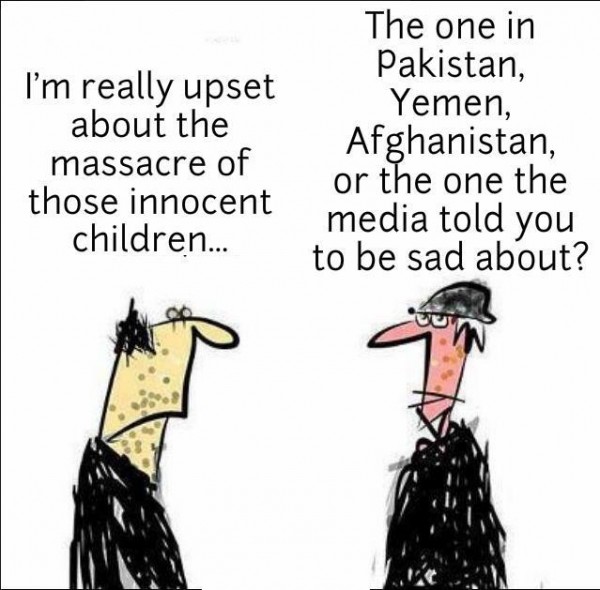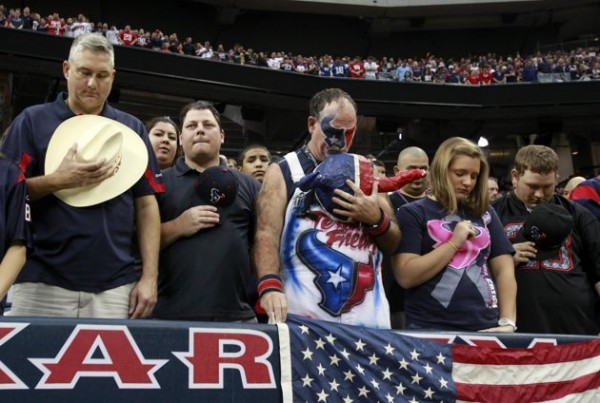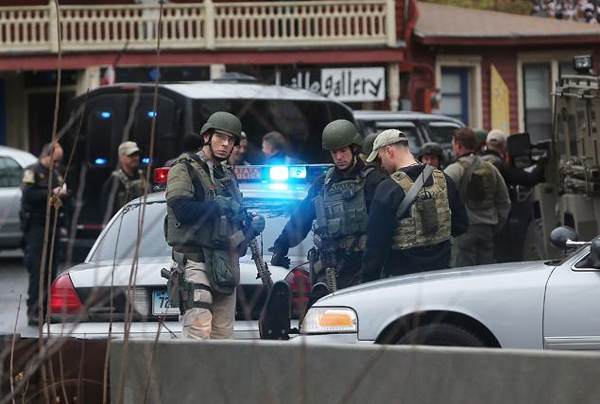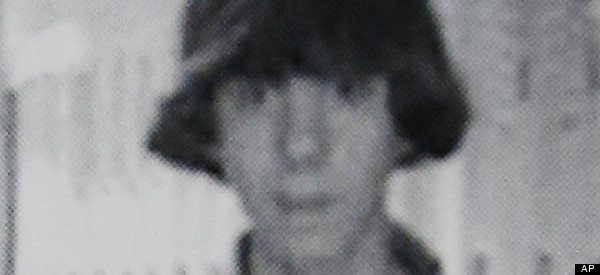Notes
The NFL and Newtown: Reflections on a Violent World
Tragedies such as last Friday’s mass shooting at Sandy Hook Elementary School prompt any number of collective responses, not least of which have been various ceremonies, tributes, and moments of silence in honor of those affected by the staggering loss of life. A Sunday vigil in Newtown, Connecticut included an appearance by President Barack Obama, who stated plainly, “These tragedies must end.” The night before, Saturday Night Live broke form and opened its live broadcast with a beautiful performance of “Silent Night” by the New York City Children’s Choir. And throughout the weekend, observers across every form of media offered words of sorrow, regret, and anger, most of them undoubtedly heartfelt.
One of the more visible sites of memorialization occurred during the weekend’s many sporting events, especially Sunday’s slate of games in the National Football League (NFL). The NFL made the decision to acknowledge the tragedy prior to each game’s kickoff, while many players modified their uniforms with personalized tributes to the victims. A Yahoo! photo essay invites us to reflect on these moments, and I think we are wise to do so. Although we may all agree that reflection is important in the wake of such a horrific tragedy, we are unlikely to agreeon the terms of that reflection. It seems to me that the visualization of these reflections—as demonstrated by these images—is something that raises a number of questions.
First and foremost, there is something deeply paradoxical about a professional sports league that trades on the glorification of sanctioned violence suddenly pausing to memorialize those killed by violence that is not sanctioned. I am not suggesting that football is akin to murder; I am, however, suggesting that taking our cues about honoring the victims of violence from an organization that prospers because of it is unsettling at best and dangerous at worst. Dave Zirin has captured this ambivalence in his column today titled, “The NFL Responds to the Sandy Hook Massacre. Should We Listen?” As he writes:
“Should our culture, and in particular the violence of the sports we consume, shoulder some of the blame? It’s an increasingly recognized fact that our most popular sport, football, is also our most violent. Every new study reveals that on Sundays we are watching people become mentally and physically crippled for our entertainment. In addition to the violence between the lines, this is a league that drapes itself in the trappings of war, from military flyovers before games to the constant slickly produced recruitment ads for the US armed forces.”
Indeed, it is this set of tensions that I find myself lingering over as the immediacy of the Sandy Hook tragedy subsides. This is why, of all the images in the Yahoo! photo essay, I am drawn to the one above.
Taken during the pre-kickoff moment of silence at Reliant Stadium in Houston, Texas, site of the Houston Texans-Indianapolis Colts game, this photo captures the prevailing emotions found in stadiums across the country during similar ceremonies. Let me preface my comments by clarifying that I do not doubt the sincerity of any of the individuals in this picture—I am simply not interested in performing some academic role through which I believe my voice is more enlightened and capable of grasping the true gravity of this event. That said, I do think there are some elements from this photograph that merit some discussion.
First, beyond the obvious solemnity of the occasion, the most compelling feature of the image is the fan more or less in the center—the gentleman who has painted his face in the red-white-and-blue Texans’ bull logo, is wearing homemade spray-painted overalls with another Texans logo and a declaration that (I believe) reads, “Texans Freak,” and brandishes what appears to be a paper mache set of red and blue Texans horns. He is at once unique and totally familiar, the Texans version of the dedicated fans of teams around the league, from the “Black Hole” in Oakland to the“Dawg Pound” in Cleveland. Devoted fans such as these are often those who are most likely to see their own identities as intimately connected to their favored franchise. This is not always or necessarily bad, but it can lead to abnormal behaviors. Of most concern to me is that it legitimizes an “us versus them” mindset that is commonplace in sports but is also far too familiar to us in politics and international affairs. Here is where Zirin’s references to militarism and war are well placed.
Notice, too, that this fan is holding one corner of the American flag, which occupies the bottom right corner of the image. Of course it may be coincidental that this particular photograph happens to include the flag against a backdrop of fans whose team happens to have red, white, and blue for its colors. Nevertheless, it spotlights the distinct “Americanness” of this event, something that I think can be read at least three ways. The first, which is the most affirmative, is that tragedies of this scope offer a rare moment when our otherwise individualistic, stratified, and alienated population may once again, even if for a moment, unite as a community. It is similar to, if on a smaller scale, the national reaction to 9/11. I believe it is undeniably a good thing that we, as an “imagined community” (Benedict Anderson’s oft-cited definition of a “nation”), can mourn together and seek to care for one another in meaningful ways. I do not wish to discredit this in any way.
Yet, a second reading speaks to some deeper concerns. Who, precisely, are the “Americans” we imagine ourselves to be? Innocent people, including children, die in this country every day, often by the most violent and unwarranted means imaginable. Although the scope of the Sandy Hook tragedy is a major factor in our collective horror and grief, we cannot escape the role of class and race in this narrative. For many citizens in the United States, Newtown, Connecticut is representative of the idealized “American Dream” mythology to which so many of us subscribe. It is affluent, picturesque, and, until last Friday, safe. It is also very white. I cannot in this space attend to all the reasons I believe race is relevant here. However, I do think that violence against a socio-economic class of such privilege shatters the illusion that somehow one can attain such a standing in American life so as to be free from conflict or violence. More problematically, it speaks to the contradictions of our society that we so easily recognize the tragedy that has befallen this affluent enclave even as we persistently turn away from the violence that mars daily life in less idealized communities.
This prompts a third reading, perhaps best summarized by this cartoon I have seen circulated on Facebook (I regret I don’t know the source):

Again, this speaks to the critique made by Zirin: that we are so outraged when arbitrary violence takes the lives of our children (as we should) even as we all but ignore the means by which our very own government sanctions and/or administers arbitrary violence that takes the lives of other nations’ children. This reveals the worst consequences of “American Exceptionalism,” a mythology that allows so many of us to condone actions that would be completely unacceptable to us if only we understood they were happening.
If you think I’ve strayed too far from the photograph, I suppose I could understand that conclusion. However, recall that the NFL has been so thoroughly articulated with nationalistic and militaristic imagery that it is virtually impossible to separate the two. I have used The Agon regularly as a platform to question the normalization of war in professional sports, especially football. I’ve made this case in many ways, but in an adapted version of my essay, “Militarism and Memorializing at the Pro Football Hall of Fame,” I write:
“Sports leagues and media have produced an almost endless list of military-themed events and programming, including flyovers, ceremonial first-pitches and coin tosses by military personnel, songs performed by members of the Armed Forces, collaborations with military charities, games sponsored by military organizations or contractors, on-field enlistment ceremonies, and near-constant platitudes from broadcasters designed to “support the troops.” Among the more recent iterations of this is a traveling museum exhibit for the Pro Football Hall of Fame called, “Pro Football and the American Spirit.” This exhibit, housed in the Hall of Fame throughout 2008 and 2009, and currently traveling throughout the country, features multiple points of identification between the game—especially in the National Football League (NFL)—and the military. As such, it shapes an audience that is positioned to view war as necessary and noble, with the mythological warrior ethos of professional football serving as rhetorical support.”
This is why the nationalistic imagery stands out for me in the photo, because I know how seamlessly it is woven into the fabric of the sport itself, especially in its most muscular, militaristic forms.
I think a final tension that is worth noting in the photo is the woman toward the right of the frame, the one wearing a Texans t-shirt with the pink ribbon and logo that represents the NFL’s efforts to support Breast Cancer Awareness Month. Sammi King, a cultural studies scholar and the author of Pink Ribbons, Inc., a critical book that has since been adapted into a documentary film, has critiqued the ways that organizations use “cause-related marketing” (often referred to as corporate social responsibility) as a means to promote their images even if their actual practices damage the very people they claim to be helping. In the case of the NFL, while it may be nice to applaud the league’s contributions to raise awareness and money toward breast cancer research, we should also question whether or not it is the right organization to speak on behalf of the needs of women. I encourage you to conduct a quick search on Google Images using the terms, “NFL,” “cheerleaders,” and “pink,” and see if you can escape the conclusion that the NFL wants to draw attention to breasts solely to have more opportunities for its core audience—heterosexual men—to ogle pretty women in skimpy outfits. In other words, the deep sexism at play cannot be masked simply through the veil of an ostensibly earnest charitable campaign.
This contradiction is important, I believe, not only because the memory is still fresh from another recent tragedy—Javon Belcher’s murder of his girlfriend, followed by his suicide—but also because the shootings in Newtown are representative of a particularly gendered phenomenon. As Salon.com’s Paul Campos asks, “Why is the shooter always male?” I urge you to read his column, as it is fair to ask why it is that men are disproportionately compelled to resolve conflicts or anxieties in catastrophically violent ways. Given the context for the picture taken in Houston, then, I can’t escape the tension between the “NFL Pink” campaign and the ease and delight with which the league, sports media, and fans consume the ritualized violence on the field.
Where does this all leave me? Frankly, I’m not sure. I know that I hate guns and that I love football. I know that I deplore the violence enacted in the name of “America” and that I am compelled to achieve my own version of the “American Dream.” I know that I am a heterosexual male who likes looking at pictures of pretty women and who resents the objectification that awaits my daughter as she grows older. I know that I, like anyone, am a walking set of contradictions and tensions. I have my own reflecting to do. My only hope is when we, as “Americans,” hear the president say that “these tragedies must end,” that we are prepared to end them. For, as Obama said, “Surely we can do better than this.”
— Michael Butterworth
Mike Butterworth is Associate Professor and Chair, Department of Communication, School of Media and Communication, Bowling Green State University, and Executive Director of the Summit on Communication and Sport. This is cross-posted from his group site, The Agon: Rhetorical Contests of Sports, Politics, and Culture.)
(photo: Richard Carson/Reuters. caption: Houston Texans fans take off their hats to observe a moment of silence in memory of the Newtown shooting victims before their NFL football game against the Indianapolis Colts in Houston December 16, 2012.)



Reactions
Comments Powered by Disqus